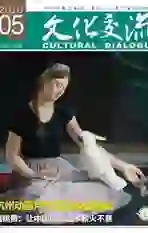李约瑟与浙江大学的渊源
2018-05-09朱原之杨之玥周炜
朱原之?杨之玥?周炜

浙江大学紫金港校区图书馆的藏书架前,一位满头银发的英国绅士兴奋得两眼放光,手舞足蹈。他是英国剑桥大学教授古克礼,也是剑桥李约瑟研究所的名誉所长。他得知,浙江大学藏书架上的书都是70多年前浙大西迁途中完好保存下来的,许多书都与一个人相关:李约瑟。
李约瑟博士(Joseph Needham,1900-1995)是英国著名的生物化学家、中国科技史家,因编写多卷本《中国科学技术史》和提出“李约瑟难题”为世人所熟知。抗日战争后期,他接受英国政府派遣出使中国,任英国驻华科学考察团团长,并组建中英科学合作馆,两次造访当时在遵义、湄潭等地办学的浙江大学。
2017年10月,古克礼代表李约瑟研究所郑重地将装订成册的史料交到浙大副校长罗卫东手中。这批捐赠史料中,包括了李约瑟1944年中国西南之行的日志、照片及文字说明,正式向英国大使馆递交的《关于1944年8-10月中国西南之旅的报告》,以及与浙江大学老校长竺可桢之间的往来通信等,均为高清电子扫描件,將入藏浙江大学档案馆。
古克礼作了一场题为《李约瑟与浙大》的报告,讲述了70多年前李约瑟与浙大的诸多往事。
两次造访浙大为中国科学家打气
1937年抗日战争全面爆发,浙江大学正式开始西迁办学的艰难历程,1940年初抵达贵州后,浙大以遵义的子弹库为总部,在湄潭设立分部,又在青岩、永兴两地先后设立一年级分部,1944年4月和10月,李约瑟与夫人、生物学家桃乐赛曾两次造访浙大,留下了大量的珍贵史料。
古克礼说,李约瑟在战时来到中国的使命,是“为中国科学家打气”。因为“在李约瑟之前,西方印象中的中国是个只有劳动人民和动人诗歌,但没有科学的国度”。李约瑟回国后在1945年10月出版的《自然》杂志上发表文章《贵州和广西的科学》,他动情地描述:
“在遵义之东75公里的湄潭,是浙江大学科学活动的中心。在那里,不仅有世界第一流的气象学家和地理学家竺可桢,有世界第一流的数学家陈建功、苏步青教授,还有世界第一流的原子能物理学家卢鹤绂、王淦昌教授。他们是中国科学事业的希望。”
在战争年代,作为科学考察团的团长,李约瑟是怎么“慧眼”识别这些最牛科学家,怎么做出浙大是当时中国最好大学的判断的呢?
古克礼说,尽管李约瑟在浙大待的时间并不长,但浙大浓厚的学术氛围给他留下了极好的印象。他主要的方式就是读论文、作报告以及面对面讨论。
日志显示,李约瑟在浙大期间做过很多场报告,“报告会上的互动是直接认识科学家的方式。”古克礼说,“他们的提问、讨论都显示着自己的学术水平,很真实。”
古克礼说,李约瑟当年就像做读书卡片一样,为遇到的每个科学家做卡片。每遇到一位科学家,李约瑟都会把对他们的印象写在一张5英寸乘以7英寸的卡片上,有些卡片上会写“非常聪明,在某某领域工作,非常有智慧”,或者“不怎么有趣”。
在坐落于剑桥大学的李约瑟研究所内,这些卡片装满6个抽屉,多数是科学家,也包括画家徐悲鸿。目前,这些卡片还没有系统整理。“如果有人追踪这些卡片上记录的科学家们的话,会非常有价值。”古克礼说。
赞誉浙大为“东方剑桥”
大多数浙江大学师生都知道李约瑟赞誉浙大为“东方剑桥”的故事。是否有可靠的证据?古克礼挠了挠脑袋说,那时还没有录音笔,所以后来1990年浙大的副校长薛继良前往英国访问李约瑟,询问了关于“东方剑桥”的说法,当时的对话是这样的:
“教授,您对‘东方剑桥这一称号是否还有印象?”
“有,我当时对竺校长这样说过。”
“虽然李约瑟当时已经90岁高龄,但他的意识、头脑都还很清楚。只是在之前的具体文字记载已经找不到了。”但是,古克礼坚定地认为“行动胜于雄辩”,他拿出一份1944年《贵州日报》的一篇报道的复印件,标题为:尼德汉(李约瑟)教授赞扬我科学家:联大浙大不啻牛津剑桥哈佛。
“这篇报道基于同年的另一篇报道,该报道记录了李约瑟与UCCL(Universities China Committee in London)的一场谈话。从李约瑟当时的记录本中可以看到,上面写着‘Zheda的提示词。或许就是在那次谈话中出现了著名言论‘东方剑桥。”古克礼教授称,李约瑟每次谈话都会提前写几个关键词,那一次写的是Zheda。
古克礼多次表示,李约瑟对浙大的感情是真挚的。李约瑟的日志中记载,李约瑟教授曾经从印度为浙大捐赠过无数实验仪器与药品试剂;到1945年底总共为浙大购置了将近300本书籍,总数已经多于中国当时任何一所学府。
与老校长竺可桢结下深厚友谊
“这所学校一共有3辆车,但我去的时候3辆都在修理。”李约瑟在考察日志中记录了战乱年代的真实状况。
在连车马交通都不便,更没有电子邮件的年代,科学家们怎么交流学术呢?日志显示,李约瑟访华期间,与浙大的罗登义、谈家桢、王淦昌、束星北等都进行过面对面的深入交流,最终,这些科学家的论文通过李约瑟建立的中英科学合作馆,带到了英国,并在《自然》等国际知名期刊上发表。
竺可桢老校长与李约瑟保持了长达30年的书信往来。在浙大期间,竺可桢是李约瑟全程的向导和陪同,是李约瑟在日志里的“Guiding Chu”。
史料捐赠现场,古克礼特意冲洗了一张竺可桢与李约瑟在意大利参加学术会议的合影,装裱在木质的相框里,送给浙大。“你知道,有一位好朋友是一件幸福的事,尤其当你有一位中国好朋友。因为他很靠谱,会诚心诚意地帮助你。”
1948年,李約瑟收到了五大箱来自中国的图书资料,并附上一张图书清单,书名和数量标注得清晰工整。这份李约瑟口中的“王子般的礼物”,正是寄自浙大的竺可桢校长,这为李约瑟日后编写他的成名作《中国科学技术史》提供了丰厚的研究资料。
In autumn 2017, Zhejiang University received a donation of historical documentation from the Needham Research Institute located on the grounds of Robinson College in Cambridge, England. Professor Christopher Cullen, a staff member with Cambridge University and honorary director of the Needham Research Institute, came with the donation all the way from England.
On October 19, Professor Cullen presented the donation to Zhejiang University on behalf of the Needham Research Institute. The donation includes Dr. Joseph Needhams journal and captioned photos of his tour in South-West China August-October in 1944, an official report on his journey dated August-October 1944 he wrote and presented to the UK embassy in China, and his correspondences with Zhu Kezhen, president of Zhejiang University during these years. All the documents are scanned copies from the originals. The documents will be housed at the Archives of Zhejiang University.
Joseph Needham (1900-1995) was a British scientist, historian and sinologist known for his scientific research and writing on the history of Chinese science and technology. He is also well known for The Needham Puzzle: Why Industrial Revolution Did Not Originate in China. Toward the end of Chinas resistance war against Japanese aggression, he was appointed by the British Government to tour China. He visited Zhejiang University twice, which journeyed all the way from Zhejiang Province to avoid war and temporarily settled down at Zunyi and Meitan, Guizhou Province in southwestern China.
At the donation ceremony, Luo Weidong, on behalf of Zhejiang University, expressed his gratitude to the Needham Research Institute for the valuable historical documents. He said that people of the 120-year-old Zhejiang University are quite familiar with Joseph Needham and the donation adds material testimonials to the important events in the history of the university. As the university is putting together a history of the university, Luo hoped more historical information would certainly make the compilation more accurate and authoritative.
After the ceremony, Professor Cullen gave a lecture on how Joseph Needham interacted with Zhejiang University over 70 years ago.
Zhejiang University began its westward odyssey after the outbreak of the nations resistance war against Japanese aggression in 1937. In early 1940, it reached Guizhou and settled in Zunyi and set up campuses respectively in Meitan, Qingyan and Yongxing. In April and October 1944, Joseph Needham and his wife Dorothy Moyle visited Zhejiang University twice. His wartime China mission was to help Chinese scientists. Before him, the west was under the impression that China was a nation of laborers and poems and that it was a nation without science. Needham published an article in Nature in October 1945, reporting what he had seen in wartime Guizhou and Guangxi. In the article, he mentioned world-class Chinese scientists such as mathematicians Chen Jiangong and Su Buqing and nuclear scientists Lu Hefu and Wang Ganchang.
How did Needham come to recognize Zhejiang University as the best higher-education institute of China? Needham read academic papers, gave lectures and talked face-to-face with people of Zhejiang University. Needhams journal reveals that he gave many lectures. The scientists with the University responded earnestly and the questions they raised and the discussions that followed indicated their world-class knowledge and perspective and insight. Needham made notes of every scientist he met in Zhejiang University. These notes were all made on 5x7 inch cards: a name and a brief comment. All the cards are packed in six drawers at the Needham Research Institute. The professor suggested that it would be very valuable if someone sorted them out systematically and traced them to see what happened in their lives and careers later.
On many occasions Professor Cullen said that Needham had a true love for Zhejiang University. His journal reveals that he bought laboratory supplies and devices in India and donated them to Zhejiang University during the wartime. By the end of 1945, he purchased nearly 300 books for Zhejiang University. Through his recommendation, Professors Luo Dengyi, Tan Jiazhen, Wang Ganchang and Shu Xingbei published their papers in renowned science journals such as Nature.
In 1948, Needham received five cartons of books from President Zhu Kezhen with a manifest of the objects shipped all the way from China. Needham considered the books as “a princely gift”. These books served as a rich source of reference s for his landmark book .
Professor Cullen was very happy to visit a valuable section at the library of Zijingang Campus of Zhejiang University. On the shelves in the section are the books Needham bought and donated to Zhejiang University in the 1940s.
